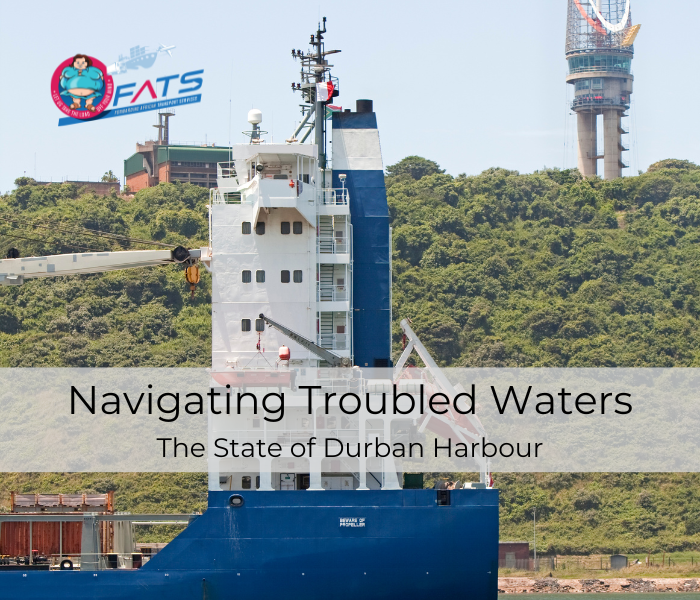The State of Durban Harbour
As we approach the holiday season, importers and stakeholders in the shipping industry are grappling with unprecedented challenges at the Port of Durban, Southern Africa’s busiest container port. The current state of congestion and inefficiency is causing significant delays, with serious implications for businesses and consumers alike.
- Christmas Rush Concerns: Importers are expressing growing concerns about missing the Christmas rush due to severe congestion at the Port of Durban. Ships are taking three to four times longer than the average – some experiencing delays of 20 days or more to offload cargo.
- Congestion Surcharge by MSC: MSC, one of the world’s largest shipping companies, has taken a proactive approach to address the congestion issue. They have announced a ‘congestion surcharge’ of $210 per 20-foot equivalent (TEU) container, effective from December 3, 2023, highlighting the seriousness of the situation.
- Port Inefficiency and Global Ranking: The inefficiency of container terminals at Durban and Ngqura is a major contributor to the slow turnaround. According to the World Bank’s 2022 ranking, these terminals were placed 365th and 361st out of 370 ports worldwide. This poor ranking is negatively impacting the entire supply chain.
- Diversion of Cargo to Maputo and Luanda: Due to inefficiencies, cargo is increasingly being diverted to other ports, resulting in a permanent loss of export traffic for South Africa. The Department of Transport’s Freight Logistics Roadmap emphasizes the urgent need for improvements.
- Labour Go-Slow and Response by TPT: Some importers believe a labour go-slow is contributing to the congestion. In response, Transnet Port Terminals (TPT) has introduced measures to improve productivity, including deploying industrial engineers and sourcing second-hand cargo handling equipment.
- Private Sector Collaboration and Concession News: Efforts are underway to introduce private sector collaboration, with the announcement that International Container Terminal Services has been chosen as the preferred bidder for a 25-year concession to run the Durban Container Terminal.
- Transnet’s Procurement Challenges and Recovery Plans: Transnet is facing challenges in its procurement process, affecting the timely replacement and refurbishment of port equipment. Despite these challenges, updates include the acquisition of seven Rubber Tyred Gantry cranes and ongoing private-sector collaborations to address the backlog.
- Recovery Rate and Current Status: The backlog stands at 60,000 containers, with an estimated 18 weeks required to clear it. The average time at anchorage is alarming, with approximately 60 ships waiting outside the port, exacerbating congestion.
- Booking System Evaluation and Future Plans: Transnet is actively evaluating the current booking system through joint collaboration, aiming to create a holistic landscape in the logistics network. Plans also include establishing a State of Logistic Index, simulation tools, and engaging with stakeholders for an efficient supply chain.
In navigating the challenges at the Port of Durban, it’s essential to acknowledge the complex interplay of natural events, port dynamics, and the intricacies of shipping lines that contribute to the current state of congestion. We find ourselves at the mercy of factors like wind, port inefficiencies, and global shipping logistics, all of which can impact the smooth flow of cargo.
However, it’s crucial to highlight that acknowledging these challenges doesn’t imply a lack of control or capability. In fact, it is within these challenges that opportunities for innovation and proactive solutions arise. While we cannot control the winds or the broader industry dynamics, we can certainly control how we respond and the value we bring to our clients.
Empowering Our Clients Through Transparency:
In light of the ongoing situation, we recognize the importance of providing our clients with tools to navigate these complexities. We are proud to offer a solution that sets us apart – a state-of-the-art live tracking system. This system, developed through strategic alliances, allows our clients to visually trace the exact location of their shipments on a map.
With real-time updates and event notifications, our clients gain unparalleled transparency into the status of their cargo. This includes estimated time of arrival (ETA) information, empowering them to make informed decisions and better manage their stock and supply chain. In times of uncertainty, having a clear visual representation of cargo movement becomes a strategic advantage.
Strategic Alliances for Future Success:
Our commitment to innovation and strategic alliances positions us as more than just a freight forwarding company. We are a partner in your success, leveraging cutting-edge technology to overcome challenges and enhance the efficiency of your logistics operations. While external factors may present hurdles, our proactive approach and commitment to providing solutions reaffirm our dedication to meeting and exceeding our clients’ expectations.
As we navigate the complexities of the current situation, rest assured that we are actively working towards minimizing disruptions and optimizing our services. Your cargo’s journey is not just a transaction for us; it’s a partnership that we nurture with care and dedication.
Stay connected for more updates on how we continue to redefine the standards of excellence in freight forwarding, ensuring that your cargo not only reaches its destination but does so with efficiency, transparency, and the highest level of service.

